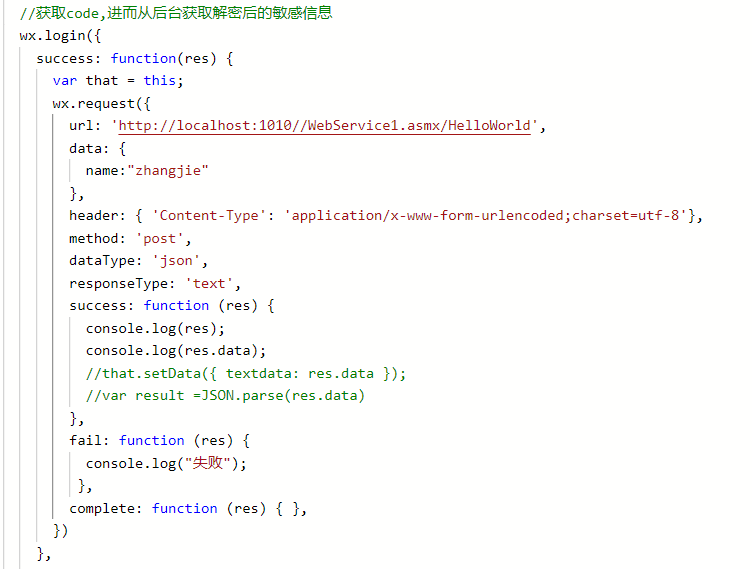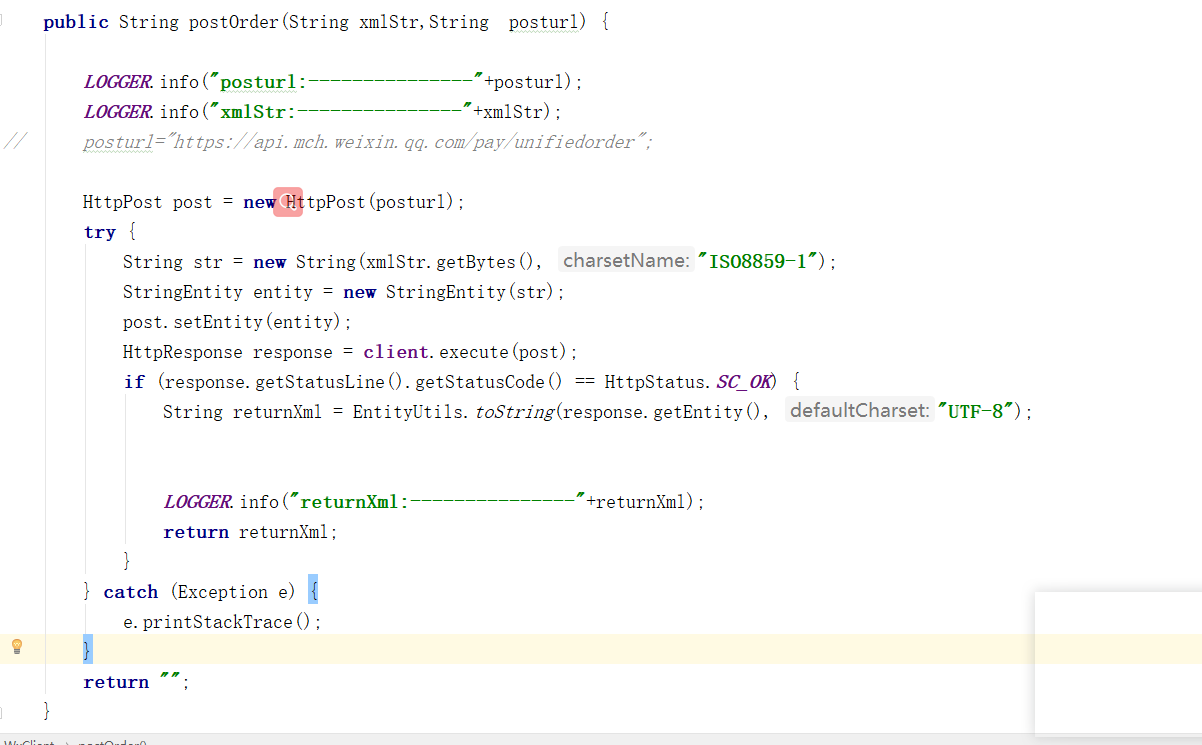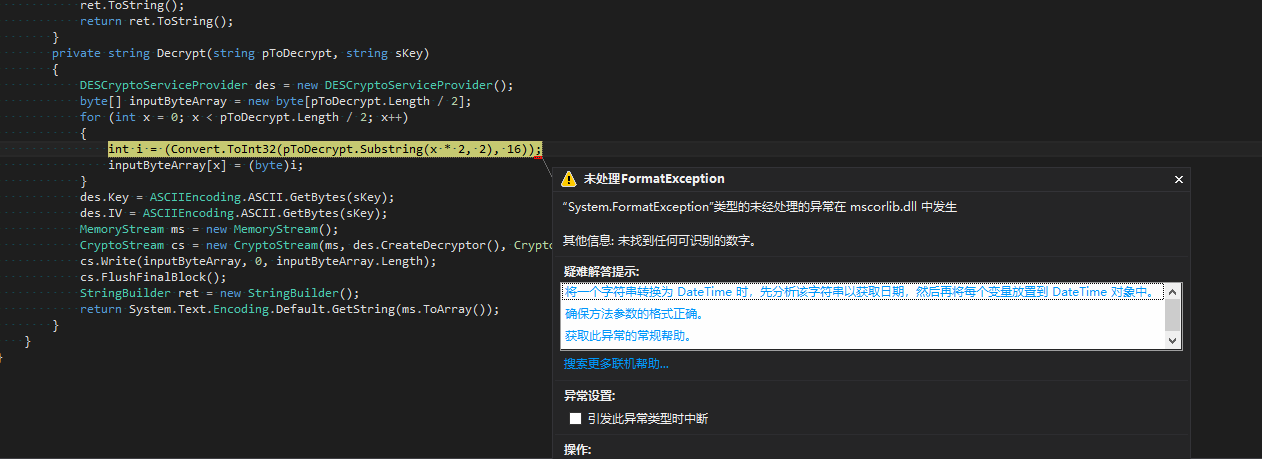可以将文章内容翻译成中文,广告屏蔽插件可能会导致该功能失效(如失效,请关闭广告屏蔽插件后再试):
问题:
I would like to ship a configuration profile with my iPhone application, and install it if needed.
Mind you, we\'re talking about a configuration profile, not a provisioning profile.
First off, such a task is possible. If you place a config profile on a Web page and click on it from Safari, it will get installed. If you e-mail a profile and click the attachment, it will install as well. \"Installed\" in this case means \"The installation UI is invoked\" - but I could not even get that far.
So I was working under the theory that initiating a profile installation involves navigating to it as a URL. I added the profile to my app bundle.
A) First, I tried [sharedApp openURL] with the file:// URL into my bundle. No such luck - nothing happens.
B) I then added an HTML page to my bundle that has a link to the profile, and loaded it into a UIWebView. Clicking on the link does nothing. Loading an identical page from a Web server in Safari, however, works fine - the link is clickable, the profile installs. I provided a UIWebViewDelegate, answering YES to every navigation request - no difference.
C) Then I tried to load the same Web page from my bundle in Safari (using [sharedApp openURL] - nothing happens. I guess, Safari cannot see files inside my app bundle.
D) Uploading the page and the profile on a Web server is doable, but a pain on the organizational level, not to mention an extra source of failures (what if no 3G coverage? etc.).
So my big question is: **how do I install a profile programmatically?
And the little questions are: what can make a link non-clickable within a UIWebView? Is it possible to load a file:// URL from my bundle in Safari? If not, is there a local location on iPhone where I can place files and Safari can find them?
EDIT on B): the problem is somehow in the fact that we\'re linking to a profile. I renamed it from .mobileconfig to .xml (\'cause it\'s really XML), altered the link. And the link worked in my UIWebView. Renamed it back - same stuff. It looks as if UIWebView is reluctant to do application-wide stuff - since installation of the profile closes the app. I tried telling it that it\'s OK - by means of UIWebViewDelegate - but that did not convince. Same behavior for mailto: URLs within UIWebView.
For mailto: URLs the common technique is to translate them into [openURL] calls, but that doesn\'t quite work for my case, see scenario A.
For itms: URLs, however, UIWebView works as expected...
EDIT2: tried feeding a data URL to Safari via [openURL] - does not work, see here: iPhone Open DATA: Url In Safari
EDIT3: found a lot of info on how Safari does not support file:// URLs. UIWebView, however, very much does. Also, Safari on the simulator open them just fine. The latter bit is the most frustrating.
EDIT4: I never found a solution. Instead, I put together a two-bit Web interface where the users can order the profile e-mailed to them.
回答1:
1) Install a local server like RoutingHTTPServer
2) Configure the custom header :
[httpServer setDefaultHeader:@\"Content-Type\" value:@\"application/x-apple-aspen-config\"];
3) Configure the local root path for the mobileconfig file (Documents):
[httpServer setDocumentRoot:[NSSearchPathForDirectoriesInDomains(NSDocumentDirectory, NSUserDomainMask, YES) objectAtIndex:0]];
4) In order to allow time for the web server to send the file, add this :
Appdelegate.h
UIBackgroundTaskIdentifier bgTask;
Appdelegate.m
- (void)applicationDidEnterBackground:(UIApplication *)application {
NSAssert(self->bgTask == UIBackgroundTaskInvalid, nil);
bgTask = [application beginBackgroundTaskWithExpirationHandler: ^{
dispatch_async(dispatch_get_main_queue(), ^{
[application endBackgroundTask:self->bgTask];
self->bgTask = UIBackgroundTaskInvalid;
});
}];
}
5) In your controller, call safari with the name of the mobileconfig stored in Documents :
[[UIApplication sharedApplication] openURL:[NSURL URLWithString: @\"http://localhost:12345/MyProfile.mobileconfig\"]];
回答2:
The answer from malinois worked for me, BUT, I wanted a solution that came back to the app automatically after the user installed the mobileconfig.
It took me 4 hours, but here is the solution, built on malinois\' idea of having a local http server: you return HTML to safari that refreshes itself; the first time the server returns the mobileconfig, and the second time it returns the custom url-scheme to get back to your app. The UX is what I wanted: the app calls safari, safari opens mobileconfig, when user hits \"done\" on mobileconfig, then safari loads your app again (custom url scheme).
- (BOOL)application:(UIApplication *)application didFinishLaunchingWithOptions:(NSDictionary *)launchOptions
{
// Override point for customization after application launch.
_httpServer = [[RoutingHTTPServer alloc] init];
[_httpServer setPort:8000]; // TODO: make sure this port isn\'t already in use
_firstTime = TRUE;
[_httpServer handleMethod:@\"GET\" withPath:@\"/start\" target:self selector:@selector(handleMobileconfigRootRequest:withResponse:)];
[_httpServer handleMethod:@\"GET\" withPath:@\"/load\" target:self selector:@selector(handleMobileconfigLoadRequest:withResponse:)];
NSMutableString* path = [NSMutableString stringWithString:[[NSBundle mainBundle] bundlePath]];
[path appendString:@\"/your.mobileconfig\"];
_mobileconfigData = [NSData dataWithContentsOfFile:path];
[_httpServer start:NULL];
return YES;
}
- (void)handleMobileconfigRootRequest:(RouteRequest *)request withResponse:(RouteResponse *)response {
NSLog(@\"handleMobileconfigRootRequest\");
[response respondWithString:@\"<HTML><HEAD><title>Profile Install</title>\\
</HEAD><script> \\
function load() { window.location.href=\'http://localhost:8000/load/\'; } \\
var int=self.setInterval(function(){load()},400); \\
</script><BODY></BODY></HTML>\"];
}
- (void)handleMobileconfigLoadRequest:(RouteRequest *)request withResponse:(RouteResponse *)response {
if( _firstTime ) {
NSLog(@\"handleMobileconfigLoadRequest, first time\");
_firstTime = FALSE;
[response setHeader:@\"Content-Type\" value:@\"application/x-apple-aspen-config\"];
[response respondWithData:_mobileconfigData];
} else {
NSLog(@\"handleMobileconfigLoadRequest, NOT first time\");
[response setStatusCode:302]; // or 301
[response setHeader:@\"Location\" value:@\"yourapp://custom/scheme\"];
}
}
... and here is the code to call into this from the app (ie viewcontroller):
[[UIApplication sharedApplication] openURL:[NSURL URLWithString: @\"http://localhost:8000/start/\"]];
Hope this helps someone.
回答3:
I have written a class for installing a mobileconfig file via Safari and then returning to the app. It relies on the http server engine Swifter which I found to be working well.
I want to share my code below for doing this. It is inspired by multiple code sources I found floating in the www. So if you find pieces of your own code, contributions to you.
class ConfigServer: NSObject {
//TODO: Don\'t foget to add your custom app url scheme to info.plist if you have one!
private enum ConfigState: Int
{
case Stopped, Ready, InstalledConfig, BackToApp
}
internal let listeningPort: in_port_t! = 8080
internal var configName: String! = \"Profile install\"
private var localServer: HttpServer!
private var returnURL: String!
private var configData: NSData!
private var serverState: ConfigState = .Stopped
private var startTime: NSDate!
private var registeredForNotifications = false
private var backgroundTask = UIBackgroundTaskInvalid
deinit
{
unregisterFromNotifications()
}
init(configData: NSData, returnURL: String)
{
super.init()
self.returnURL = returnURL
self.configData = configData
localServer = HttpServer()
self.setupHandlers()
}
//MARK:- Control functions
internal func start() -> Bool
{
let page = self.baseURL(\"start/\")
let url: NSURL = NSURL(string: page)!
if UIApplication.sharedApplication().canOpenURL(url) {
var error: NSError?
localServer.start(listeningPort, error: &error)
if error == nil {
startTime = NSDate()
serverState = .Ready
registerForNotifications()
UIApplication.sharedApplication().openURL(url)
return true
} else {
self.stop()
}
}
return false
}
internal func stop()
{
if serverState != .Stopped {
serverState = .Stopped
unregisterFromNotifications()
}
}
//MARK:- Private functions
private func setupHandlers()
{
localServer[\"/start\"] = { request in
if self.serverState == .Ready {
let page = self.basePage(\"install/\")
return .OK(.HTML(page))
} else {
return .NotFound
}
}
localServer[\"/install\"] = { request in
switch self.serverState {
case .Stopped:
return .NotFound
case .Ready:
self.serverState = .InstalledConfig
return HttpResponse.RAW(200, \"OK\", [\"Content-Type\": \"application/x-apple-aspen-config\"], self.configData!)
case .InstalledConfig:
return .MovedPermanently(self.returnURL)
case .BackToApp:
let page = self.basePage(nil)
return .OK(.HTML(page))
}
}
}
private func baseURL(pathComponent: String?) -> String
{
var page = \"http://localhost:\\(listeningPort)\"
if let component = pathComponent {
page += \"/\\(component)\"
}
return page
}
private func basePage(pathComponent: String?) -> String
{
var page = \"<!doctype html><html>\" + \"<head><meta charset=\'utf-8\'><title>\\(self.configName)</title></head>\"
if let component = pathComponent {
let script = \"function load() { window.location.href=\'\\(self.baseURL(component))\'; }window.setInterval(load, 600);\"
page += \"<script>\\(script)</script>\"
}
page += \"<body></body></html>\"
return page
}
private func returnedToApp() {
if serverState != .Stopped {
serverState = .BackToApp
localServer.stop()
}
// Do whatever else you need to to
}
private func registerForNotifications() {
if !registeredForNotifications {
let notificationCenter = NSNotificationCenter.defaultCenter()
notificationCenter.addObserver(self, selector: \"didEnterBackground:\", name: UIApplicationDidEnterBackgroundNotification, object: nil)
notificationCenter.addObserver(self, selector: \"willEnterForeground:\", name: UIApplicationWillEnterForegroundNotification, object: nil)
registeredForNotifications = true
}
}
private func unregisterFromNotifications() {
if registeredForNotifications {
let notificationCenter = NSNotificationCenter.defaultCenter()
notificationCenter.removeObserver(self, name: UIApplicationDidEnterBackgroundNotification, object: nil)
notificationCenter.removeObserver(self, name: UIApplicationWillEnterForegroundNotification, object: nil)
registeredForNotifications = false
}
}
internal func didEnterBackground(notification: NSNotification) {
if serverState != .Stopped {
startBackgroundTask()
}
}
internal func willEnterForeground(notification: NSNotification) {
if backgroundTask != UIBackgroundTaskInvalid {
stopBackgroundTask()
returnedToApp()
}
}
private func startBackgroundTask() {
let application = UIApplication.sharedApplication()
backgroundTask = application.beginBackgroundTaskWithExpirationHandler() {
dispatch_async(dispatch_get_main_queue()) {
self.stopBackgroundTask()
}
}
}
private func stopBackgroundTask() {
if backgroundTask != UIBackgroundTaskInvalid {
UIApplication.sharedApplication().endBackgroundTask(self.backgroundTask)
backgroundTask = UIBackgroundTaskInvalid
}
}
}
回答4:
I think what you are looking for is \"Over the Air Enrollment\" using the Simple Certificate Enrollment Protocol (SCEP). Have a look at the OTA Enrollment Guide and the SCEP Payload section of the Enterprise Deployment Guide.
According to the Device Config Overview you only have four options:
- Desktop installation via USB
- Email (attachment)
- Website (via Safari)
- Over-the-Air Enrollment and Distribution
回答5:
This page explains how to use images from your bundle in a UIWebView.
Perhaps the same would work for a configuration profile as well.
回答6:
Have you tried just having the app mail the user the config profile the first time it starts up?
-(IBAction)mailConfigProfile {
MFMailComposeViewController *email = [[MFMailComposeViewController alloc] init];
email.mailComposeDelegate = self;
[email setSubject:@\"My App\'s Configuration Profile\"];
NSString *filePath = [[NSBundle mainBundle] pathForResource:@\"MyAppConfig\" ofType:@\"mobileconfig\"];
NSData *configData = [NSData dataWithContentsOfFile:filePath];
[email addAttachmentData:configData mimeType:@\"application/x-apple-aspen-config\" fileName:@\"MyAppConfig.mobileconfig\"];
NSString *emailBody = @\"Please tap the attachment to install the configuration profile for My App.\";
[email setMessageBody:emailBody isHTML:YES];
[self presentModalViewController:email animated:YES];
[email release];
}
I made it an IBAction in case you want to tie it to a button so the user can re-send it to themselves at any time. Note that I may not have the correct MIME type in the example above, you should verify that.
回答7:
I\'ve though of another way in which it might work (unfortunately I don\'t have a configuration profile to test out with):
// Create a UIViewController which contains a UIWebView
- (void)viewDidLoad {
[super viewDidLoad];
// Tells the webView to load the config profile
[self.webView loadRequest:[NSURLRequest requestWithURL:self.cpUrl]];
}
// Then in your code when you see that the profile hasn\'t been installed:
ConfigProfileViewController *cpVC =
[[ConfigProfileViewController alloc] initWithNibName:@\"MobileConfigView\"
bundle:nil];
NSString *cpPath = [[NSBundle mainBundle] pathForResource:@\"configProfileName\"
ofType:@\".mobileconfig\"];
cpVC.cpURL = [NSURL URLWithString:cpPath];
// Then if your app has a nav controller you can just push the view
// on and it will load your mobile config (which should install it).
[self.navigationController pushViewController:controller animated:YES];
[cpVC release];
回答8:
Not sure why you need a configuration profile, but you can try to hack with this delegate from the UIWebView:
- (BOOL)webView:(UIWebView *)webView shouldStartLoadWithRequest:(NSURLRequest *)request navigationType:(UIWebViewNavigationType)navigationType{
if (navigationType == UIWebViewNavigationTypeLinkClicked) {
//do something with link clicked
return NO;
}
return YES;
}
Otherwise, you may consider enable the installation from a secure server.
回答9:
Just host the file on a website with the extension *.mobileconfig and set the MIME type to application/x-apple-aspen-config. The user will be prompted, but if they accept the profile should be installed.
You cannot install these profiles programmatically.
回答10:
This is a great thread, and especially the blog mentioned above.
For those doing Xamarin, here\'s my added 2 cents. I embedded the leaf cert in my app as Content, then used the following code to check it:
using Foundation;
using Security;
NSData data = NSData.FromFile(\"Leaf.cer\");
SecCertificate cert = new SecCertificate(data);
SecPolicy policy = SecPolicy.CreateBasicX509Policy();
SecTrust trust = new SecTrust(cert, policy);
SecTrustResult result = trust.Evaluate();
return SecTrustResult.Unspecified == result; // true if installed
(Man, I love how clean that code is, vs. either of Apple\'s languages)




